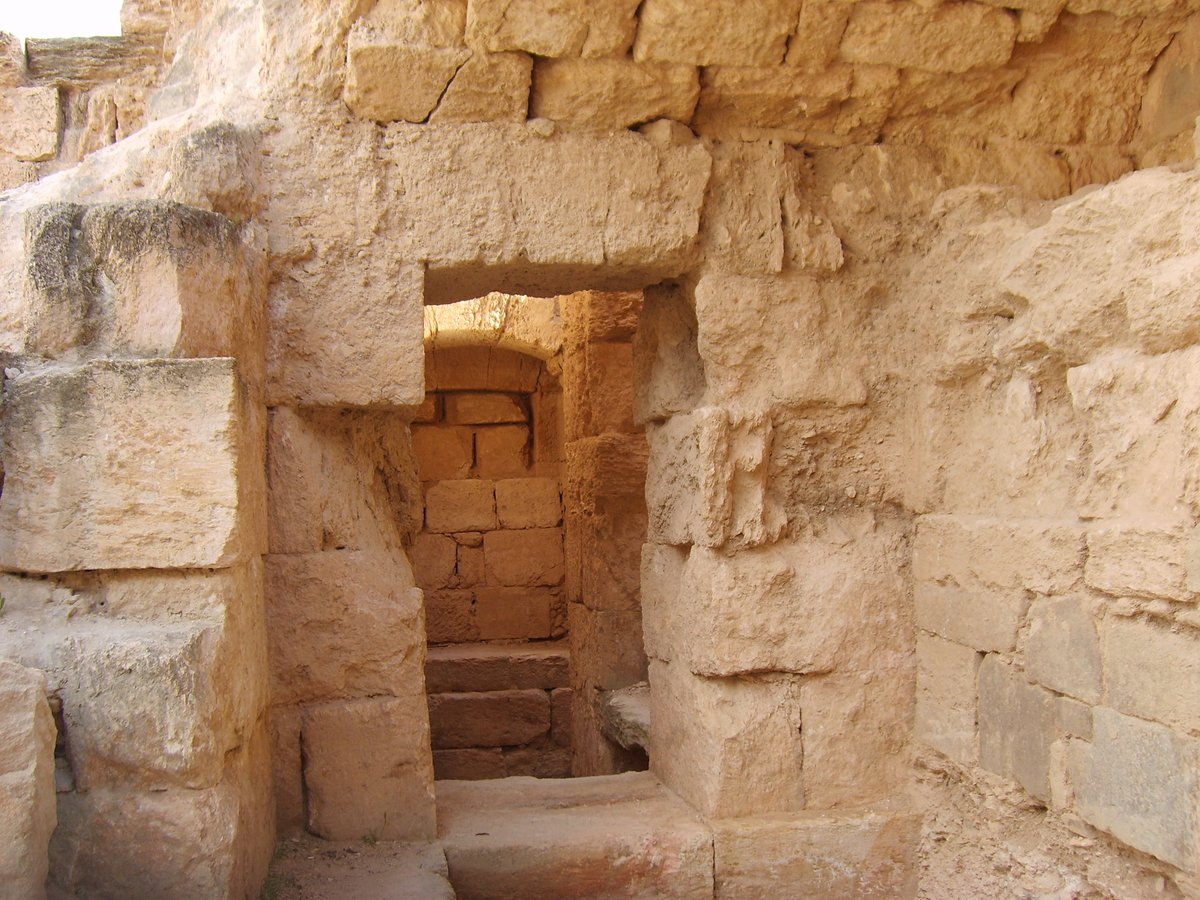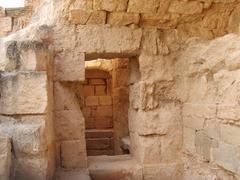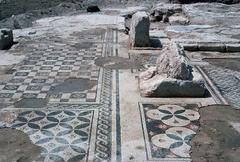
Bayt Ras Irbid Jordan: Visiting Hours, Tickets, and Travel Guide
Date: 03/07/2025
Introduction to Bayt Ras Historical Site in Irbid, Jordan
In the hills just northeast of Irbid, northern Jordan, Bayt Ras (ancient Capitolias) stands as a testament to the region’s layered history and cultural richness. Once a thriving Decapolis city, Bayt Ras preserves the legacy of Roman, Byzantine, and early Islamic civilizations through its remarkable archaeological remains, including a well-preserved Roman theater and the unique painted tomb. This guide explores Bayt Ras’s origins, significance, and practical travel information—providing everything you need for an immersive visit (Wikipedia: Capitolias; ADAJ 60; PathsofJordan; Audiala; ACOR; One in the Orange Jacket).
Historical Background
Origins and Early Settlement
Bayt Ras occupies the site of ancient Capitolias, one of the famed Decapolis cities. Settlement began in the late 1st century BCE, with formal foundation marked by coinage from 97/98 CE. The name Bayt Ras derives from the Aramaic “Bet Reisha,” attesting to its deep Semitic roots (Wikipedia: Capitolias; ADAJ 60).
Roman and Hellenistic Periods
Capitolias flourished under Roman rule, its urban landscape characterized by a colonnaded street, forums, temples, and its signature Roman theater. The city’s prosperity is evidenced by extensive remains: city walls, gates, aqueducts, workshops, a military cemetery, and a winery (ADAJ 60).
Byzantine and Early Islamic Eras
The city continued to thrive into the Byzantine period, as seen in church foundations, and later adapted to Islamic rule, with the conversion of religious buildings and continued viticulture. Bayt Ras’s wine was celebrated by poets and geographers well into the Islamic era (Wikipedia: Capitolias).
Archaeological Highlights
The Roman Theater
Bayt Ras’s most iconic monument, the 2nd-century CE Roman theater, is carved into a hillside and once seated up to 3,000 spectators. It remains a centerpiece for cultural events and visitor exploration (Audiala).
Painted Tombs
Discovered in 2016, the painted tomb is a rare, intact Roman hypogeum adorned with vivid frescoes and over 50 inscriptions in Greek and Aramaic. The iconography reveals funerary rituals, social life, and Capitolias’s foundation myths (PathsofJordan; PCMA). Conservation and research are ongoing, with public access via guided tours or virtual exhibits (ISPRAmbiente).
Other Archaeological Remains
Bayt Ras also features remnants of city walls, colonnaded streets, a bath complex, Byzantine churches, and panoramic viewpoints. These layers offer insight into the city’s continuous importance from antiquity through the medieval era.
Visiting Bayt Ras: Essential Information
Opening Hours
- General Site (Theater & Ruins): Daily, 8:00 AM – 6:00 PM (seasonal variations; check locally)
- Painted Tomb: Saturday–Thursday, 8:00 AM – 5:00 PM. Closed Fridays and public holidays. Access may be limited to guided tours.
Tickets and Admission
- Roman Theater and Archaeological Park: Free entry; donations encouraged for site maintenance.
- Painted Tomb: 3 JD for adults, 1 JD for students/children under 12. Purchase tickets at the visitor center.
Guided Tours
- Highly recommended for in-depth understanding. Arrange via the Department of Antiquities, Irbid Tourism Office, or local travel agencies (ACOR Newsletter).
Accessibility
- The site has uneven terrain and steps; limited accessibility for those with mobility challenges. Contact the Department of Antiquities in advance for assistance.
Amenities
- Restrooms at the main entrance.
- On-site interpretive gallery with 3D virtual tours.
- Cafes and shops in Bayt Ras village; wider dining/accommodation options in Irbid.
How to Get There
- By Car: 10–15 minutes north of Irbid city; well-signposted. Ample parking.
- By Taxi: Readily available from Irbid.
- Public Transport: Local minibuses run from Irbid, but schedules may be irregular (Wide World Trips; WildTrips).
Tips for Visitors
- Best Time to Visit: Spring (March–May) and autumn (September–November) for mild weather.
- What to Bring: Comfortable shoes, sun protection, water, and snacks.
- Photography: Allowed in most outdoor areas; restrictions apply in the painted tomb.
- Cultural Etiquette: Dress modestly, greet locals with “Salam Alaikum,” and ask permission before photographing people.
- Combine Attractions: Pair a visit to Bayt Ras with day trips to Umm Qais, Pella, and Ajloun Castle (WildTrips).
Accommodation and Dining
Stay in Irbid for a range of hotels, from budget guesthouses to business-class accommodations. Recommended options include:
- Azmal Hotel & Suites
- Sedrah Hotel
- Rum Royal Suites
- Sara Crown Hotel
- Flamingo Hotel Irbid
- Nahas Plaza
(Booking.com)
Enjoy traditional Jordanian and Palestinian cuisine in Irbid’s restaurants, such as Jasmine Restaurant and Al Quds Restaurant.
Conservation and Responsible Tourism
Bayt Ras is a site of ongoing excavation and conservation. Support preservation by:
- Not touching or climbing on ruins.
- Respecting barriers and conservation staff.
- Supporting local businesses and community initiatives (ACOR Newsletter).
Frequently Asked Questions (FAQ)
Q: What are the visiting hours for Bayt Ras?
A: The archaeological site is open 8:00 AM–6:00 PM; the painted tomb is open 8:00 AM–5:00 PM, Saturday–Thursday.
Q: Is there an entrance fee?
A: General site access is free; the painted tomb requires a ticket (3 JD adults, 1 JD children/students).
Q: Are guided tours available?
A: Yes, and they are highly recommended for a full experience.
Q: Is the site accessible for people with disabilities?
A: Accessibility is limited. Contact the Department of Antiquities for possible assistance.
Q: What else can I visit nearby?
A: Umm Qais, Ajloun Castle, Jerash, and the Irbid Archaeological Museum are all within easy reach.
Visuals and Media Suggestions
Include images of:
- The Roman theater (alt: “Bayt Ras Roman Theater seating and stage”)
- Panoramic hilltop views (alt: “Panoramic view of Irbid plains from Bayt Ras”)
- Painted tomb frescoes (alt: “Frescoes in Bayt Ras painted tomb, Capitolias”)
- Local vineyards (alt: “Vineyards near Bayt Ras showcasing Jordan’s wine heritage”)
Virtual tours and high-quality visuals are available through the Bayt Ras Tomb Project, the Department of Antiquities, and official tourism platforms.
Useful Resources and Further Reading
- Wikipedia: Capitolias
- ADAJ 60 English
- PathsofJordan
- ISPRAmbiente: Bayt Ras Tomb Project
- Jordan Times
- PCMA: Beit Ras Archaeological Site
- ACOR: Bayt Ras
- One in the Orange Jacket: Things to Do in Irbid
- Audiala: Bayt Ras and Irbid Region
- Wide World Trips: Tourist Places to Visit in Irbid
- WildTrips: Irbid Jordan What to Visit
- ACOR Newsletter
- Booking.com’s Bayt Ras listings
Explore Bayt Ras for a journey through history—where ancient artistry, archaeological wonders, and local traditions converge in northern Jordan. For audio tours and curated itineraries, download the Audiala app and follow us for updates on Jordan’s archaeological treasures.


